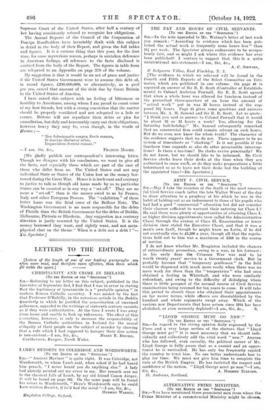THE PAY AND HOURS OF CIVIL SERVANTS. [To THE EDITOR
OF THE " SPECTATOR."' SIR,—In the note appended to Mr. Watney's letter of last week you remark : " According to evidence which has been pub- lished the actual work is frequently some hours less" than 341 per week. The Spectator always endeavours to be scrupu- lously fair, and so might I ask where this evidence has ever been published? I venture to suggest that this is a quite unintentional mis-statement.—I am, Sir, &c., [The evidence to which we referred will be found in the Fourth and Fifth Reports of the Select Committee on Esti- mates, which are published in one volume. On page 40 is reported an answer of Sir R. R. Scott (Controller of Establish- ments) to Colonel Assheton Pownall. Sir R. R. Scott agreed that when a whole hour was allowed for luncheon instead of the prescribed three-quarters of an hour the amount of " actual work " put in was 33 hours instead of the sup- posed 341 hours. Page 45 gives some questions and answers between Mr. A. M. Samuel and Sir R. R. Scott. Let us quote : "I think you said in answer to Colonel Pownall that it would he about 32 or 33 hours a week? Yes, allowing for the Saturday half-holiday." Mr. Samuel subsequently remarked that no commercial firm could remain solvent on such hours. But do we even now know the whole truth? The character of the evidence suggests that we do not. There appears to be no system of time-sheets or " clocking." Is it not possible if the luncheon time expands so also do other permissible interrup- tions? Is there a tea-time? Do clerks arrive punctually? We do not know, but we should like to be informed. Do Civil Service clerks leave their desks at the time when they are authorized to cease work, or do they make preparations a little beforehand so as to leave not their desks but the building at the appointed time?—En. Spectator.]


































 Previous page
Previous page